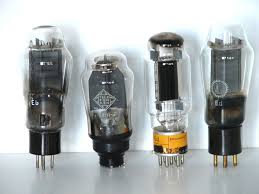Modern Computer
In 1943, a team of mathematicians based at Bletchley Park near London, England built a computer called Colossus to help them crack secret German codes. Colossus was the first fully electronic computer. Instead of relays, it used a better form of switch known as a vacuum tube (also known, especially in Britain, as a valve).
The vacuum tube, each one about as big as a person's thumb and glowing red hot like a tiny electric light bulb, had been invented in 1906 by Lee de Forest (1873–1961), who named it the Audion. This breakthrough earned de Forest his nickname as "the father of radio" because their first major use was in radio receivers, where they amplified weak incoming signals so people could hear them more clearly. In computers such as the ABC and Colossus, vacuum tubes found an alternative use as faster and more compact switches.

Vacuum tube
By 1974, Intel had launched a popular microprocessor known as the 8080 and computer hobbyists were soon building home computers around it. The first was the MITS Altair 8800, built by Ed Roberts. With its front panel covered in red LED lights and toggle switches, it was a far cry from modern PCs and laptops. Even so, it sold by the thousand and earned Roberts a fortune. The Altair inspired a Californian electronics wizard name Steve Wozniak ("Woz") to develop a computer of his own: the Apple I.
When he showed off his machine to his colleagues at the club, they all wanted one too. One of his friends, Steve Jobs (1955–2011), persuaded Woz that they should go into business making the machine. Woz agreed so, famously, they set up Apple Computer Corporation in a garage belonging to Jobs' parents. After selling 175 of the Apple I for the devilish price of $666.66, Woz built a much better machine called the Apple ][ (pronounced "Apple Two"). In just two and a half years, Apple sold around 50,000 of the machine, quickly accelerating out of Jobs' garage to become one of the world's biggest companies.
Apple ][ (Apple Two)
Apple's success selling to businesses came as a great shock to IBM and the other big companies that dominated the computer industry. One year later, it released the IBM Personal Computer (PC), based on an Intel 8080 microprocessor, which rapidly reversed the company's fortunes and stole the market back from Apple. When IBM was developing its personal computer, IBM turned to a young programmer named Bill Gates. His then tiny company, Microsoft, rapidly put together an operating system called DOS, based on a product called QDOS (Quick and Dirty Operating System), which they acquired from Seattle Computer Products.
